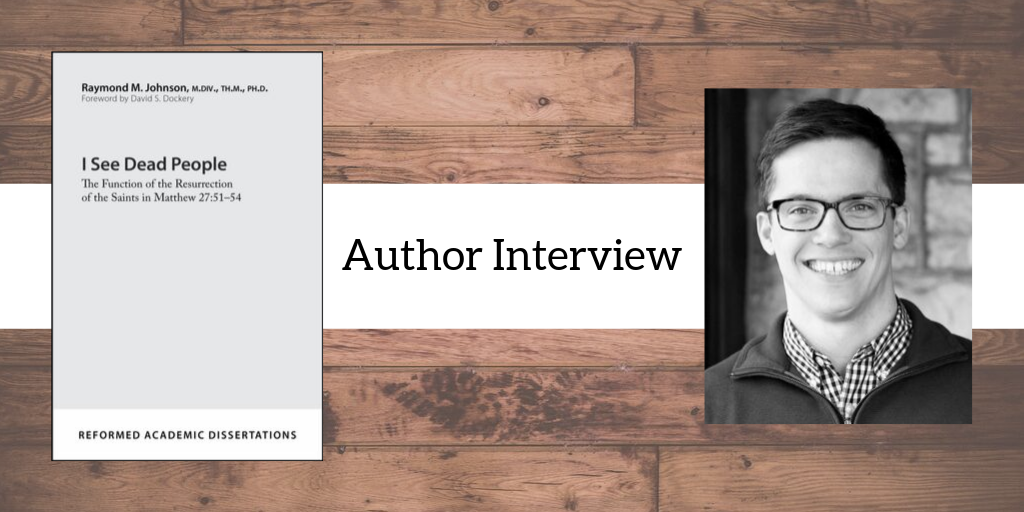This week’s author interview is with Raymond Johnson. He is the author of the new Reformed Academic Dissertations, I See Dead People: The Function of the Resurrection of the Saints in Matthew 27:51–54.
- Tell us a little bit about yourself.
I tell people I grew up in LA – Lower Alabama. My wife’s name is Meghan and we have five children – Abigail Renee, Charlotte Patricia, Emily Elizabeth, Michael Lee, and Eleanor Ruth. I’m the Senior Pastor of Christ Church West Chester in West Chester, Pennsylvania. In this season of our family’s life, there is not a lot of spare time, so my personal interests and hobbies are filled with things like: dancing to “Baby Shark,” playing Legos and cars, teaching my kids Latin, reading Harry Potter out loud, and riding bikes.
- Which writers inspire you?
C.S. Lewis and Saint Augustine
- What inspired you to write this book, about this topic?
Intrigue with this difficult Matthean pericope came while reflecting on how I would preach this particular text meaningfully as an M.Div. student in a Matthew Exegesis course with what would become my Ph.D. Supervisor, Jonathan Pennington, in the Fall of 2010 at Southern Seminary. As I perused commentaries on Matthew and consulted major works on the resurrection, I realized that there was a vast interpretive chasm that existed between exegetes and homileticians on how this text functioned within Matthew’s narrative as well as to what this particular pericope meant for readers of Matthew’s Gospel. After realizing that few preachers sought to explicate the meaning of this Matthean pericope in their homiletical endeavors and that there was neither much scholarly consensus nor any expert help in relation to this Matthean pericope, I desired to seek interpretive clarity in relation to Matthew’s use of this scene in his Gospel.
It became apparent that many contemporary interpreters relied on a translation of the Matthean pericope that argued for a full stop punctuation in the middle of Matthew 27:52. The full stop, for these interpreters, conveyed a temporal lapse between the time when the tombs opened as a result of the earthquake in Matthew 27:51 and the subsequent resurrection of the sleeping saints in Matthew 27:52-53. Further, for these interpreters, this temporal gap enables them to reconcile Matthew’s pericope with the subsequent teaching in the epistles that Jesus is the firstborn from the dead (1 Cor 15:20; cf. Col 1:18; Rev. 1:5). This interpretation, it seemed, was helpful in dealing with a “pesky” text, but was too convenient. It seems to be more concerned with reading the conclusion to Matthew’s Gospel in light of the epistles rather than in light of Matthew; it presumes that Matthew’s crafting of the conclusion to his Gospel was haphazard in that he “misplaced” a resurrection account. Consequently, it seems to force a reading of the pericope in Matthew 27:45-28:20 that is foreign to Matthew’s literary intentions. On the other hand, however, other interpreters argued that the passage should not be understood historically since the imagery in Matthew 27:45-54 has apocalyptic overtones—darkness over the land (27:45), a revelatory earthquake (25:51), a zombie-esque resurrection (27:52-53), the metaphorical destruction of temple (27:51). Though the passage definitely has apocalyptic connotations and cosmic significance, it is certainly not ahistorical. Thus, again, I found this interpretation hermeneutically and homiletically unsatisfying. When it came time for these hermeneutical readings to positively inform my homiletical endeavors, there seemed to be much lacking. Specifically, there is a lack of clarification and consensus on the literary structure of Matthew 27:45-28:16. Moreover, both the homiletical implications of the passage as well as hermeneutical understanding as to the type of resurrection these “saints” participated in were unclear when following these readings of the text. I could, therefore, come to no satisfactory conclusions.
After composing the paper, the text was brought to attention in the evangelical world due to a debate over Michael Licona’s work, The Resurrection of Jesus: A New Historiographical Approach. The controversy surrounding Licona’s work, along with the plethora of ways that the passage had been appropriated by interpreters, further peaked my interest in ascertaining the meaning(s) of this Matthean pericope.
In my homiletical struggling with the text, I stumbled upon the idea of reading the conclusion to Matthew’s Gospel narratologically, or as “story.” Rather than falling on either side of the interpretive chasm, it seems that a narratological reading informed by reception history provides a more in-depth analysis and meaning to this Matthean pericope. Leveraging historical appropriations and exegetical study have shown that Matthew has carefully crafted this portion of his Gospel as he has the entirety of the rest of his Gospel.
- What book are you reading now?
- Frederick Douglass: Prophet of Freedom by David Blight
- Wise Counsel: John Newton’s Letters to John Ryland Jr. edited by Grant Gordon
- Loosing the Lion: Proclaiming the Gospel of Mark by Leroy Huizenga
- The Cross of Christ by John R. W. Stott
- The Preacher’s Catechism by Lewis Allen
- Favorite sport to watch?
College Football. I grew up watching it with my dad. My favorite team is the Alabama Crimson Tide.
- The Lord of the Rings or The Chronicles of Narnia?
Both. I have a map of Middle Earth and Narnia hanging on the wall in my study. A good story, like good preaching, invites investment. It moves people. Both of these stories encourage readers to respond with a variety of emotions to the characters and their situations as the fiction molds the character of readers.
How can readers discover more about you and your work?
-
- Website: http://www.christchurchwc.org
- Twitter: @raymondj17
- Facebook Page: https://www.facebook.com/raymond.johnson.14268


Comments